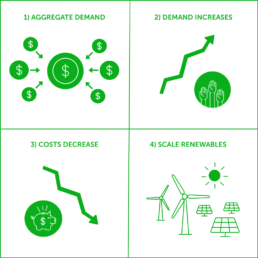Since the 45th President of the United States took power in January, his comprehensive carbon agenda has won him few friends amongst those working to meet ambitious climate goals across the world. As Sustainia’s recently launched Cities100 2017 shows however, cities are pushing forward even faster than ever, with 381 U.S. Mayors now committed to intensifying their efforts to combat climate change. One emerging trend from this year’s publication is the use of demand aggregation models to accelerate renewable technologies, and it turns out that President Trump’s 1987 book ‘The Art of the Deal’ contains a few top tips.
Use Your Leverage
The concept of demand aggregation is a simple, but underutilised tool that can lower costs and reduce risks of renewable technologies, driving competition and innovation in the sector. Trump wisely advises us to use leverage and come from a position of strength when making a deal, and by partnering with others and aggregating demand, investors of all shapes and sizes can play their part in scaling the technologies of tomorrow, today.
Whilst the Microsofts and Googles of this world operate on large enough scales to buy hundreds of megawatts of renewable energy, demand aggregation allows smaller firms, cities and institutions to join together with power purchase agreements for new solar farms, or citizens to take control of the low-carbon energy transition through community-owned renewable energy schemes.

Think Big
Trump’s number one key to unlocking business success is to think big. One wonders how much inspiration this gave to the team in Los Angeles City Hall who have spearheaded an initiative aggregating demand for 114,000 electric vehicles (EVs) across American cities, worth $10 billion. An order of that magnitude, representing over 70% of the 2016 US market, is set to be a significant driver in the EV market, and expected to boost investor confidence despite turbulence at a federal level.
As the sun sets in Indiana, it rises in India, where the government has a target installing 100 GW of solar capacity by 2022. With the window of opportunity to reach that goal rapidly closing, scaling is needed at greater speed, and demand aggregation is set to play a key role. Companies are coming together under the umbrella of the Green Power Market Development Group to aggregate demand for renewable energy and capitalise on the cost savings and environmental benefits. Between 2014-2017, the group facilitated 200 MW of renewable projects, and, having learnt many lessons along the way, aim to bring online a further 800 MW of capacity by 2020.
Contain the Costs
‘The Art of the Deal’ teaches us to never spend a penny more than we need to, something that demand aggregation helps us to achieve. The small city of Lancaster, California, has taken energy supply into its own hands, creating a city-owned utility company and aggregating renewable energy demand from residents to guarantee clean energy at competitive rates. Domestic, public and private users are all opting for the scheme, and saved a cumulative $1 million in energy costs during the first year. Customers can choose a 100% renewable option for a small additional cost, and rates are set at public meetings; power to the people. By the end of this year, Lancaster aims to reach net-zero energy status.
Far to the south of Trump’s great border wall, the city of Santiago in Chile must have been flicking through the pages of the ‘Art of the Deal’ too. The municipality, which is investing $5 million in rooftop solar projects and efficiency retrofits between 2015 and 2018, has aggregated demand for solar projects across the city, driving down costs from $5.40 to $0.96 per installed watt.
Fight Back
Across the world and across business sectors, demand aggregation is being used more and more to push back against Trump’s comprehensive carbon agenda. It is an emerging and promising tool that empowers citizens in the transition to a more sustainable tomorrow. And according to ‘The Art of The Deal’, “if you’re fighting for something you believe in… things usually work out for the best in the end.”
Our reply, Mr President, to quote you: “You can’t con the people, at least not for long.”
Author: Nic Craig

